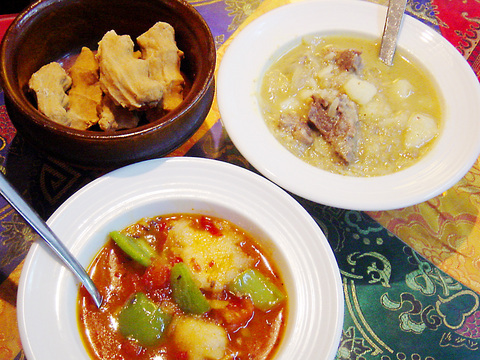If you can't find time in your busy schedule to take a trip on the Qinghai-Tibet railroad and venture to the Roof of the World, a Tibetan restaurant called Samdom hidden in a quiet alley in the Shida (師大) neighborhood offers home-cooked Tibetan meals.
Having lived in Taiwan for 10 years, Tibetan Kelsang Chodaic decided to try his luck and run a small business of his own. “There are a few thousand Tibetans living in Taiwan and most of them have made their home in Taipei. Sometimes we miss the food from home which can't be found anywhere in the city. So I opened this place to serve my fellow Tibetans and our cuisine to Taiwan,” Chodaic said.
According to Chodaic, typical Tibetan cuisine is light in taste and is usually boiled. Indian and Chinese influences are evident in many of the restaurant's dishes.

PHOTO: HO YI
Coming to a Tibetan restaurant, one simply can't pass up the regions' staple food pag, also called Tibetan parched barley cake. The scented dried paste should be broken into pieces using your hands, and is eaten as an accompaniment to main dishes.
If you opt for an authentic dinning experience, mutton and beef are the customary choices on a Tibetan family's dinning table, while chicken, seafood and vegetables are rarely served. The joint's light, fragrant stews are pleasantly familiar to local palates. And the plate of spicy fried beef lungs in tomato sauce (NT$100) is the eatery's specialty for more adventurous dinners.
Momo, the Tibetan steamed beef dumplings are another must-try on the menu. For people who prefer to mix the exotic with a tinge of familiarity, one of the popular dishes catering to local tastes is the chili chicken mixed with green bell pepper and onion (NT$80).
As for an after-meal drink, the well-known Tibetan butter beverage is definitely worth trying, even though the possibility is high that you will find the slightly salty and rich refreshment is not your cup of tea. A household beverage in Tibet, the tea is traditionally made with salt, goat's milk and butter and the concoction enjoys a novelty appeal among non-Tibetans. In Samdon however, goat's milk is replaced by cow's milk.

Wooden houses wedged between concrete, crumbling brick facades with roofs gaping to the sky, and tiled art deco buildings down narrow alleyways: Taichung Central District’s (中區) aging architecture reveals both the allure and reality of the old downtown. From Indigenous settlement to capital under Qing Dynasty rule through to Japanese colonization, Taichung’s Central District holds a long and layered history. The bygone beauty of its streets once earned it the nickname “Little Kyoto.” Since the late eighties, however, the shifting of economic and government centers westward signaled a gradual decline in the area’s evolving fortunes. With the regeneration of the once

Even by the standards of Ukraine’s International Legion, which comprises volunteers from over 55 countries, Han has an unusual backstory. Born in Taichung, he grew up in Costa Rica — then one of Taiwan’s diplomatic allies — where a relative worked for the embassy. After attending an American international high school in San Jose, Costa Rica’s capital, Han — who prefers to use only his given name for OPSEC (operations security) reasons — moved to the US in his teens. He attended Penn State University before returning to Taiwan to work in the semiconductor industry in Kaohsiung, where he

In February of this year the Taipei Times reported on the visit of Lienchiang County Commissioner Wang Chung-ming (王忠銘) of the Chinese Nationalist Party (KMT) and a delegation to a lantern festival in Fuzhou’s Mawei District in Fujian Province. “Today, Mawei and Matsu jointly marked the lantern festival,” Wang was quoted as saying, adding that both sides “being of one people,” is a cause for joy. Wang was passing around a common claim of officials of the People’s Republic of China (PRC) and the PRC’s allies and supporters in Taiwan — KMT and the Taiwan People’s Party — and elsewhere: Taiwan and

Perched on Thailand’s border with Myanmar, Arunothai is a dusty crossroads town, a nowheresville that could be the setting of some Southeast Asian spaghetti Western. Its main street is the final, dead-end section of the two-lane highway from Chiang Mai, Thailand’s second largest city 120kms south, and the heart of the kingdom’s mountainous north. At the town boundary, a Chinese-style arch capped with dragons also bears Thai script declaring fealty to Bangkok’s royal family: “Long live the King!” Further on, Chinese lanterns line the main street, and on the hillsides, courtyard homes sit among warrens of narrow, winding alleyways and